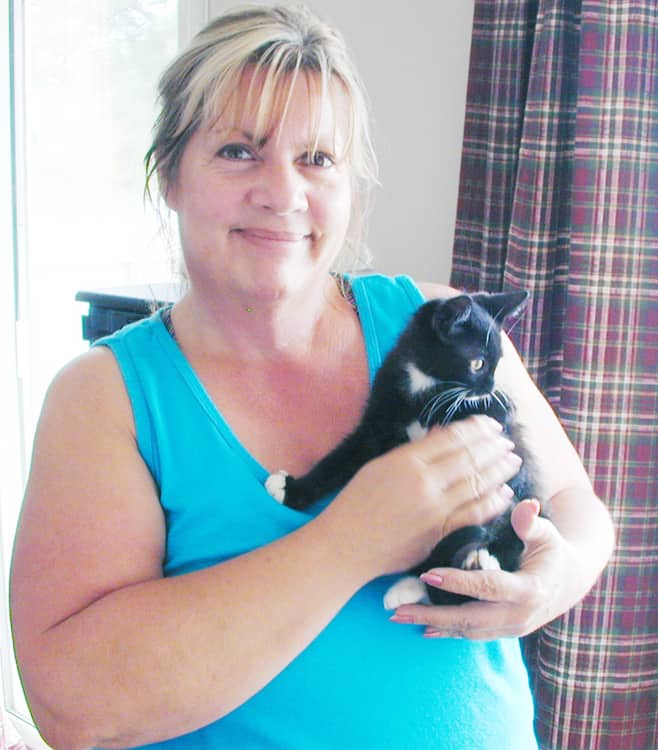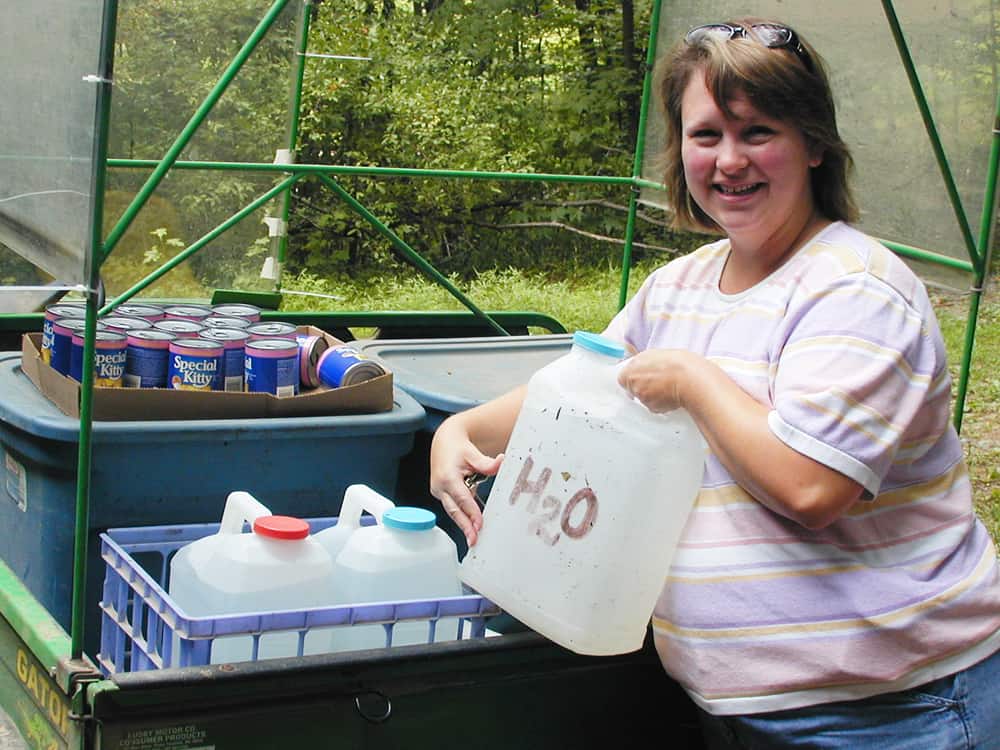Scratching Out a Home in the Woods
The woman driving the green John Deere Gator knows her way through the woods of almost-wild Southern Maryland. She’s been driving these rutted dirt paths for eight years to care for the hundred-plus inhabitants of the region’s only sanctuary for feral cats.
Petite, energetic and almost fanatically committed to the cats, Carol Hall is a founder of Friends of Felines, the cat-rescue organization responsible for the sanctuary. Branches slap the plastic windshield as we bounce our way into a clearing to see a collection of small, wooden shelters.
“These are our snuggle boxes,” Hall explains.
The three-sided boxes give shelter to cats too wild to live with humans as pets. The boxes are grouped together, four or more in each little colony. Lined with straw for extra warmth, each snuggle box can house six cats.
|
Of the 500 feral cats the group rescues each year, more than a third are young enough to be socialized until they can be adopted as indoor pets. 
|
We’re not there long before a gray tiger cat peaks out from behind a tree. Another wanders into the clearing. Soon another. Then another.
“They know the sound of the Gator,” Hall says. “They figure it’s dinner time.”
These cats don’t look wild. They keep their distance but appear unafraid. All are clean, bright-eyed and healthy. Not exactly lap cats, they are hardly fearsome. Hall recognizes all of them, calling each by name. They are her babies, rescued from what Hall calls “dangerous colonies” and now living a life of cat leisure in the relative safety of the woods.
“These are cats that cannot be adopted or returned to their original colony,” Hall says. “This sanctuary is the last chance for these Calvert County cats.”
Saving Cats
The mission to save Calvert’s wild cats began in 2001 when the founding father of Friends of Felines — who wishes to remain anonymous — learned that county animal control was trapping a colony of feral cats at a Huntingtown trash compactor site. The trapped cats would be euthanized.
“The county had trapped out that colony in the past,” Hall says. “But new cats always returned to fill the void. That’s the natural order. Of course the cats multiplied until they became a problem at the site, and the cycle repeated.”
The founder got permission to trap the colony, have the cats tested, spayed or neutered, vaccinated, micro-chipped, ear tipped, then returned to the compactor site, where he agreed to feed and maintain the colony.
The result was a stable, healthy feral cat colony that was no longer reproducing or fighting. And no longer a job for the county’s animal control officers.
Encouraged by the success of the Huntingtown colony, like-minded cat lovers combined forces and organized Friends of Feral Felines with a mission to “trap, neuter, return, maintain” colonies of feral cats in Calvert and Anne Arundel counties.
Friends of Felines return the wildest half of their rescued cats to their colonies, now supported by volunteers with food and vigilance, lest colony stability be shaken by newcomers or illness.
Other rescued cats not quite so wild are adopted as barn cats, willing to be fed and vetted by their new owners but not about to move into the house.
More than a third of the cats Friends of Felines rescue are young enough to be socialized — another job for volunteers — until they can be adopted as indoor pets.
Deborah Williams is a volunteer kitty foster parent. The guest room and bathroom in her Dares Beach home serves as a kitty kennel. This month she’s caring for eight tiny mewing balls of fluff rescued from a Cox Road colony.
 Deborah Williams, right, is a volunteer kitty foster parent. The guest room and bathroom in her Dares Beach home serves as a kitty kennel. “It’s a lot of work,” she says. “But I’m glad I’m able to do it.” |
“It’s a lot of work,” the real estate appraiser says. “But I’m glad I’m able to do it.”
If not for the rescue, these foster kittens would have all died; the entire litter suffered from an upper respiratory infection. They’ll graduate from Williams’ care as house kitties looking for adoptive families.
The Friends had a good plan, as far as it went. But they still had the problem of cats that couldn’t be adopted or returned to safe colonies. Euthanasia wasn’t an option.
In 2002, the rescue group appealed to Calvert County for help. The Calvert Board of County Commissioners unanimously granted them the use of 198 restricted-use county acres as a sanctuary.
“The county let us use the land, and a grant from PetSmart allowed us to set up and operate the sanctuary,” Hall says.
In 2004, the cat lovers organized as a 501(c)3 renamed Friends of Felines Inc. The group relies on donations and grants for all operating costs.
Since 2002, the sanctuary community has grown to over 100 cats.
Saving Bucks
Friends of Felines’ mission is first and foremost humane. But “trap, neuter, return and maintain” is also a cost-effective solution to the area’s feral cat dilemma.
Each cat taken to the Tri-County Animal Shelter costs taxpayers $100. That doesn’t include food or euthanizing; just bureaucratic costs and some basic vetting.
The Friends of Felines rescues an average of 500 cats a year.
“Do the math,” says Hall. “That’s $50,000 the taxpayers don’t have to pay. And 500 animals saved.”
But even rescued cats can still get into the pockets of county taxpayers when they run afoul of Calvert Animal Control.
Sanctuary cats are not licensed, because, as Hall explains, they do not have owners. They are, in her words, “community cats.” They are not fenced into the sanctuary, and some cats go on walkabouts.
But county law requires licenses for all cats and dogs. If animal control picks up unlicensed pets, the officers have to follow the rules, and the rules direct them to the Tri-County Animal Shelter.
“Animal control officers know those cats are ours,” says Hall. “All of our cats have been micro-chipped and have an ear notch. But instead of just bringing it back here or calling one of us to come and get it, they take it to the shelter.”
Hall maintains the county law wastes both taxpayer money and Tri-County Shelter’s limited resources. For years, the enforcement of the ordinance has been a thorn in the Feline Friends’ paw.
After years of howling, the increasingly vocal rescue group is getting a hearing with Sheriff Mike Evans, whose department oversees Calvert Animal Control.
“I’m open to suggestions to save time and money and to do something for the animals,” Evans told Bay Weekly, days before meeting with the Friends. “The ordinance was put in by the County Commissioners,” he said. “They can change it.”
It’s a Cat’s Life
Back at the sanctuary, it’s just another day in paradise — for the cats. For the volunteers, every day means loading the Gator with dry and canned cat food and jugs of fresh water for the bouncy ride to scattered feeding stations.
“I’m here every Friday,” says volunteer Tamara Ealley of Huntingtown as she packs the Gator for her weekly run.
 Volunteer Tamara Ealley, above, became involved with Friends of Felines when she discovered a colony of feral cats on her property. With the rescue group’s help, a dozen cats were trapped, neutered and vaccinated and released back to the colony. Ealley feeds them, too. |
Ealley became involved with Friends of Felines when she discovered a colony of feral cats on her property. With the rescue group’s help, a dozen cats were trapped, neutered and vaccinated and released back to the colony. Ealley feeds them, too.
On the sanctuary or in community colonies, “Volunteers feed and water the cats every day, seven days a week,” Hall says. “In all kinds of weather.”
Sanctuary cats are fed only at feeding stations. The stations are easy to identify by the colorful array of plastic pet food bowls. A few have raised feeding platforms, an experiment to keep raccoons from enjoying the buffet.
Each month, the sanctuary cats eat about 800 pounds of food, purchased with donations.
Donation is the operative word at the sanctuary.
“We are always in need of something,” Hall says. “Especially building materials for acclimation units and snuggle boxes: lumber, plywood, wire fence, tarps, cinderblocks, straw.
Under the Friends’ agreement with the county, no permanent structures are allowed. Before winter’s cold arrives, Hall is on another mission: To obtain cinder blocks to raise the snuggle boxes off the ground and above any snow.
Another ongoing project is building acclimation units. These fenced pens house newly relocated cats for two weeks while they acclimate to their surroundings. Each unit is furnished with a snuggle box and food bowls to get the cats used to what they’ll encounter on the outside. When the cats have settled in, the door to the pen is opened and the new residents run free.
These wild cats are safe, healthy and well fed.
They are likely happy cats, at home in the woods, and they are not your problem.
To learn more or help: www.friends-of-felines.com
